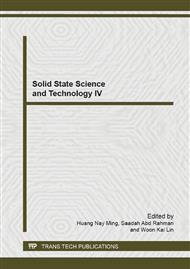p.390
p.395
p.400
p.407
p.411
p.415
p.420
p.424
p.429
Calculation of Confined Electron and Hole States in a Strained InAs-GaAs Pyramidal Quantum Dot System Based on Effective Mass Approximation
Abstract:
Computational studies on zero dimensional semiconductor structure have been centred on typically produced quantum dot of various geometries namely pyramidal and lens with lateral sizes ranging from 10 nm to 24 nm. In the case of an epitaxially grown quantum dot, strain plays another essential role apart from its size and shape in determining its electronic properties [. Among the most studied strained structures is the self-assembled InAs quantum dot capped by a GaAs matrix. A study by [ on InAs pyramidal quantum dot predicted no confined electron states for quantum dot with base lengths 6 nm and below. Nevertheless, a calculation by [3] based on atomistic psedudopotential predicted at most two confined states for both electron and hole in a self-assembled InAs-GaAs quantum pyramid system of base length 6.06 nm.
Info:
Periodical:
Pages:
411-414
Citation:
Online since:
February 2014
Authors:
Price:
Сopyright:
© 2014 Trans Tech Publications Ltd. All Rights Reserved
Share:
Citation:


